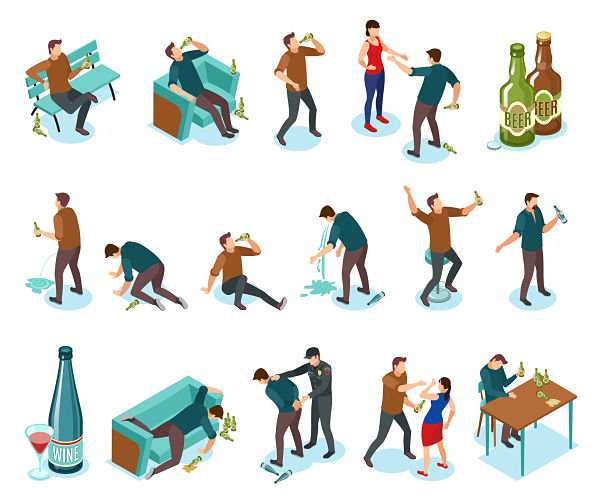
Risky Drinking: Who’s Most Susceptible?
Alcohol expectancies and valuations are as fluid as a river. They can rise and fall with the tide or be as still and as bright as a full moon. They can be seasonal, attracting or repelling with the weather. Or questionable, and dependent upon what lies deeply beneath. Whatever the case, they can swiftly bring in a current of risky drinking.
Or not. Because the likelihood of risky drinking pretty much equals the likelihood of sobriety. It really all depends upon the person and the day. Well, it depends upon how a person is feeling about drinking on a given day anyway. And if that person feels a drink will do them good, well, you can bet they’ll have drink in hand by sundown. If however they feel drinking is merely a prelude to disaster, then you may just find them taking a chair at AA.
That’s roughly what the Research Society on Alcoholism (RSA) found out after they had 433 college students share their beliefs concerning alcohol. Of course, the good folks at the RSA were a lot more eloquent about it all. A lot more thorough too. But you get the gist. You don’t? Well, by all means read on!
Drinking and Consequences
The study paper’s title is Young People’s Fluctuating Beliefs on Alcohol’s Effects Influence Their Drinking and Consequences. So you see, the gist is really drinking and its consequences. Or, more to the point, the consequences of drinking will be determined by what one believes those consequences will be.
Yeah, we know. It all sounds a little Que sera sera. That’s because in many respects it is just that. But it’s also just the opposite. Or can be. If you believe one drink will put you in a good mood and then have one drink, well you’ll probably wind up in a good mood. On the other hand, if you believe one drink will put you in a good mood and then have six of seven, you’re going to end up nothing but drunk.
“Expecting positive or favorable effects (that is, positive expectancies) has been associated with greater drinking and negative consequences.”
Bam!
The same applies to valuation, that is, a person’s beliefs about how good or bad certain outcomes of alcohol use would be.
“Similar to expectancies, more positive valuations are linked to greater alcohol use.”
The Breakdown
The 433 college students (average age 20) were culled from two west coast universities. They’d each also reported at least one heavy drinking episode within the past month. The participants were surveyed at baseline and after 3, 6 and 12 months in order to assess their weekly alcohol use (i.e. average number of drinks per week), as well as alcohol beliefs and negative drinking consequences.
Expectancies and valuations were broken down into 38 potential drinking outcomes. “Positive expectancies and valuations included sociability (e.g. “I would be outgoing”), tension reduction (“I would feel relaxed”), liquid courage (“I would feel courageous”) and sexuality (“I would feel sexy”). Negative expectancies and valuations included cognitive and behavioral impairment (e.g. “I would be clumsy”), risk and aggression (e.g. “I would act aggressively”), and self-perception (e.g. “I’d feel moody”).”
Negative consequences, in turn, were broken down into 23 potential outcomes (i.e. “neglected your responsibilities”, “had a fight/argument/bad feelings with a friend”) within the past three months.
The Variety of Drinking Expectancies and Valuations
The students’ alcohol expectancies and valuations varied substantially over time, with women showing more variability than men. It didn’t matter whether those expectancies and valuations were positive or negative. They both affected alcohol use and consequences.
When participants held relatively greater sociability, sexuality, and risk/aggression expectancies, they drank more. When participants expected greater effects on self-perception, they drank less. Furthermore, greater expectancies for sexuality and self-perception produced more negative consequences.
Weekly drinking was higher when students reported more favorable risk/aggression valuation, and negative consequences were greater when they reported more favorable self-perception valuation. No expectancies or valuations were associated with fewer consequences of drinking, and several associations differed among men and women.
Reducing Risky Drinking
The RSA’s goal is to reduce risky drinking and its consequences among young adults. To do that, it’s crucial to understand the risk factors. This study makes great strides toward doing just that.
The current findings also have important clinical implications. They could even inform interventions designed to challenge young people’s beliefs around alcohol. One way would be to target negative expectancies rather than the customary positive ones. Another would be specifically tailoring intervention approaches to men and women.
There’s a lot to chew on here. Throw sex into the mix (as the original study does) and you’ve got even more. But without data there can be no progress. And we wholeheartedly applaud the Research Society on Alcoholism’s drive to become impactfully informed. Kudos too to Alcoholism: Clinical and Experimental Research for publishing the study (and Newswise for getting it out there), and to the International Society for Biomedical Research on Alcoholism for backing the RSA all the way.
How ’bout you? Did you run into the wrong side of your expectations? Have you been engaging in a little too much risky drinking? Would you like to stop? Help is all around you know. As close as a phone call. But first you’ve gotta pick up the phone. Try it. Call NIDA. Call SAMHSA. Or call Healing Properties. Just call someone. Get the help you need. Please.
(Image: Shutterstock)